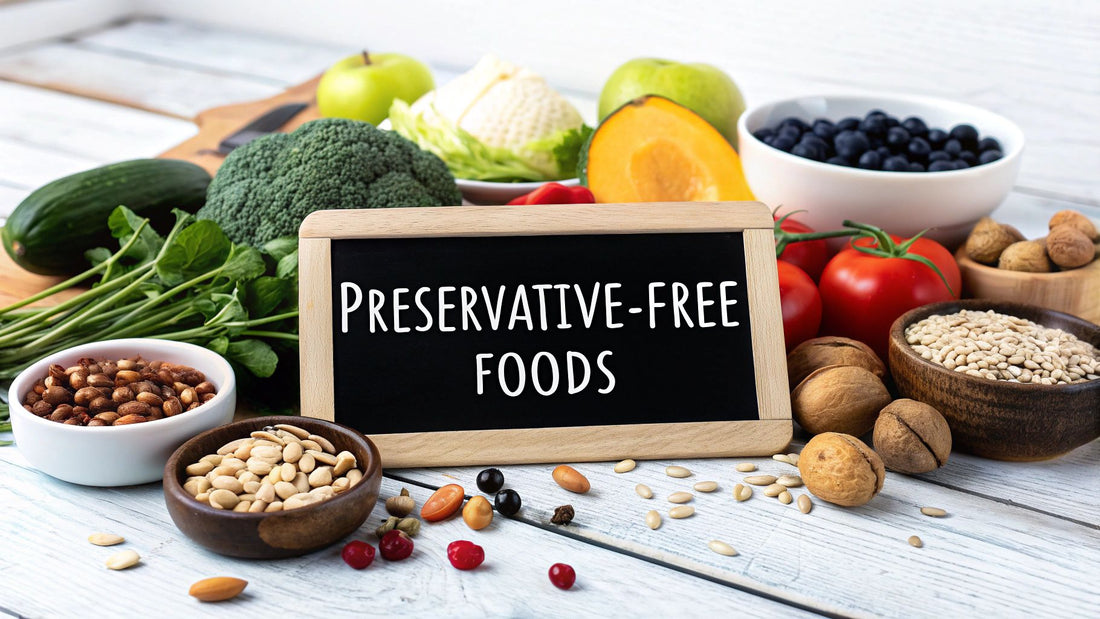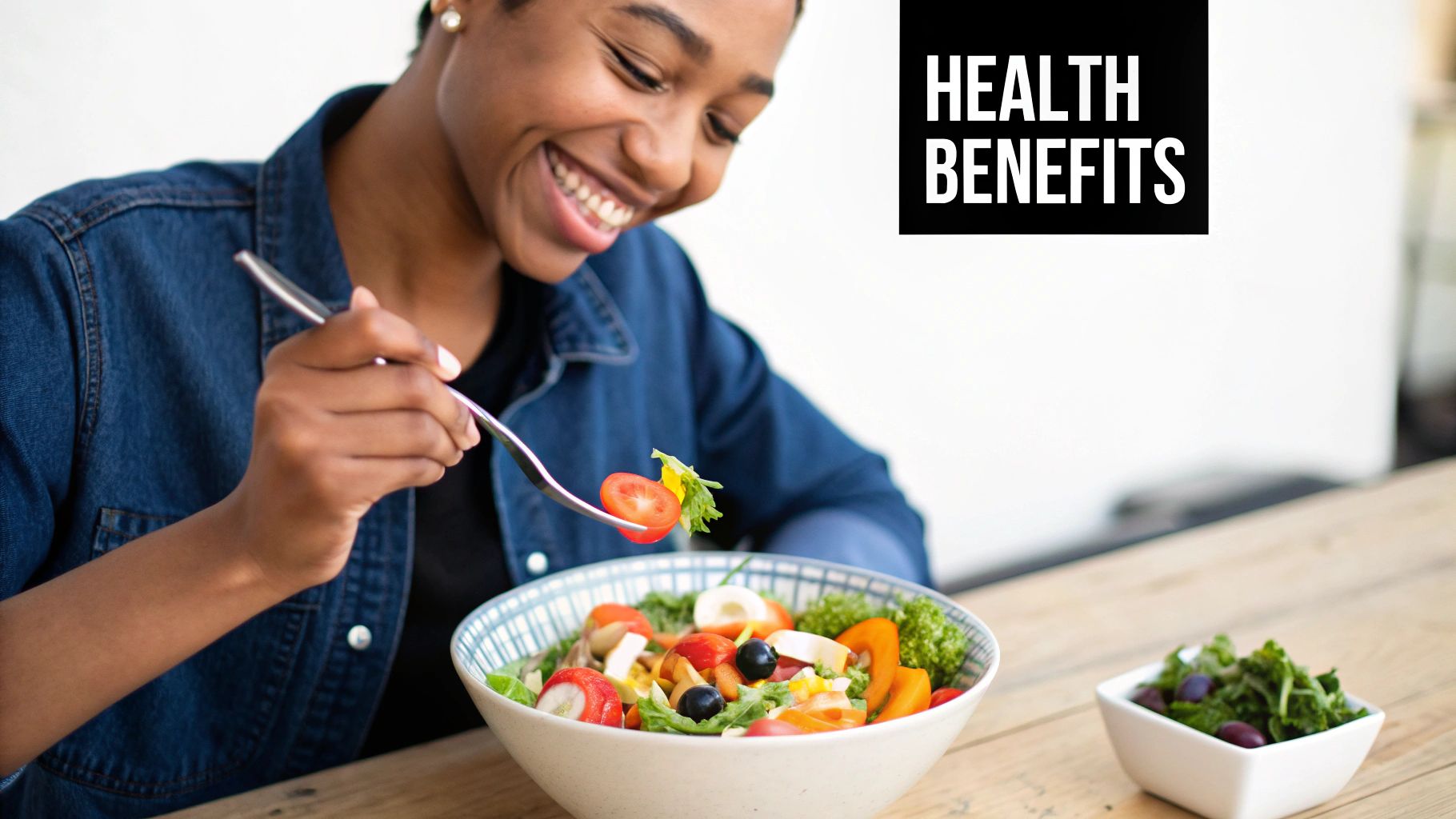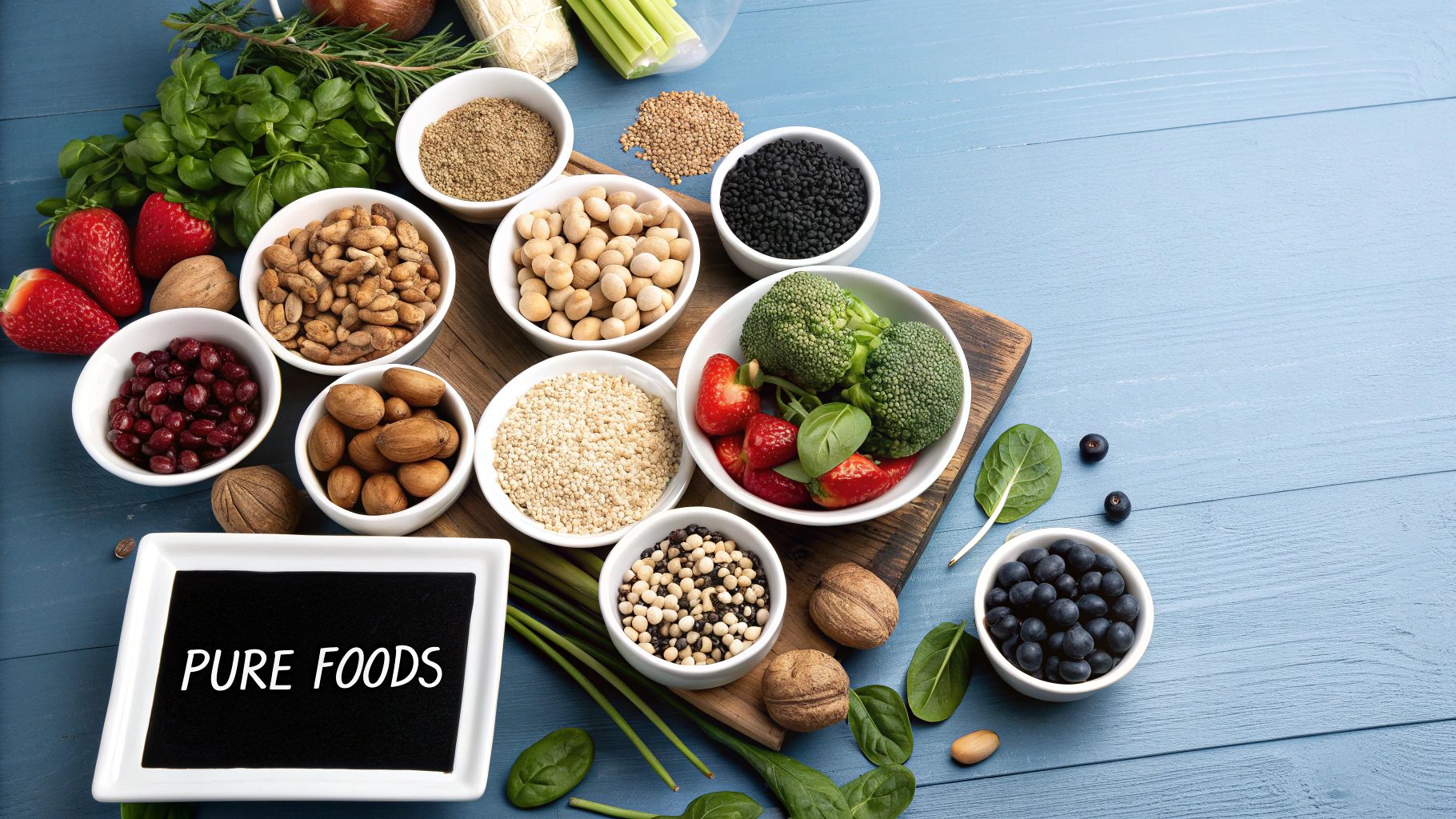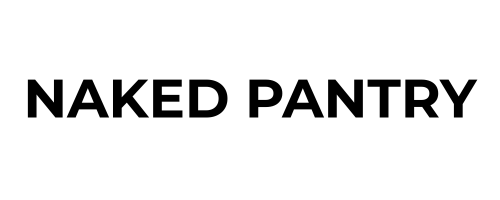
A Guide to Foods Without Preservatives
Share
When we talk about foods without preservatives, we're really just talking about food in its most honest state. Think whole, unprocessed ingredients that stay fresh thanks to simple, natural methods like keeping them cold or sealing them in an airtight container—not by adding synthetic chemicals.
Choosing these foods is a choice for flavor and nature over an unnaturally long shelf life.
What Are Preservatives in Our Food Anyway?

You can think of preservatives as a "pause button" for food. They're designed to stop spoilage in its tracks, making products last for weeks, months, or even years on a shelf. This was a game-changer for our food supply, making it possible to ship food across the country and keep it safe to eat.
But there’s a massive difference between the preservatives our ancestors used and the synthetic ones common today. For centuries, people have naturally preserved food with ingredients from their own pantries:
- Salting and curing fish and meat.
- Pickling cucumbers and other veggies in vinegar.
- Using sugar to turn fruit into jams and jellies.
These methods are simple, effective, and use ingredients you can actually pronounce.
The Rise of Synthetic Additives
Fast forward to today, and the food industry often relies on synthetic, lab-made preservatives like benzoates, sorbates, and nitrates. Why? Because they're cheap and incredibly effective for mass-produced foods. This shift was all about cutting costs and maximizing convenience, which fundamentally changed how our food gets from the farm to our tables.
The widespread use of these additives was a pivotal change, driven by industrial efficiency. Choosing foods without preservatives is really about returning to a more natural and transparent way of eating.
It's eye-opening to see what's actually in some of our food. For a deeper dive, it’s worth checking out the 7 food additives outlawed in Europe that are still allowed in the U.S. Knowing what to look for is the first step toward making better choices every time you shop.
The Real Reason Everyone Is Talking About Natural Foods
It seems like everywhere you look, people are talking about natural foods. This isn't just another passing health fad; it’s a real, grassroots movement. Shoppers are flipping over packages, actually reading the labels, and asking tough questions about ingredients they can't pronounce.
What's driving this? A simple, but powerful, desire to know what we're putting into our bodies. When an ingredient list looks more like a high school chemistry test, it’s natural to wonder about the long-term impact. We're collectively shifting from just grabbing what's convenient to making deliberate choices for our health.
The Power of the Clean Label
You've probably heard the term "clean label" thrown around, and it's become a gold standard for a good reason. It’s all about finding products with short, simple ingredient lists filled with things you recognize. It’s the difference between a homemade tomato sauce and a jarred one packed with things like sodium benzoate and artificial colors to keep it shelf-stable for years.
This push for transparency is making waves across the entire food industry. As more of us say "no" to synthetic additives, companies are getting the message and going back to basics with more honest, traditional ingredients. This isn't a small trend; it's a global shift.
This consumer-led demand for foods without synthetic preservatives has sparked a massive interest in natural, plant-based alternatives. North America currently holds about 31% of the global market share, largely due to strict food safety regulations and high consumer expectations for quality and transparency.
It’s about more than just avoiding a few chemicals. It’s a whole philosophy centered on eating food that's as close to its original state as possible. The market is definitely listening. You can discover more about this market shift to see just how significant it is.
Ultimately, our collective voice is sending one clear message: we want real food. When you choose a preservative-free option, you’re doing more than just making a healthy choice for yourself. You’re casting a vote for a better, more natural food system for everyone.
Better Flavor and Health Without Synthetic Additives

Choosing foods without preservatives is about more than just dodging a few chemicals on an ingredients list. It’s a genuine upgrade to how you eat and experience food every day. When you strip away the artificial stuff, what you're left with is pure, unadulterated flavor.
Foods in their most natural state just taste better. They have textures and tastes that synthetic additives often try to imitate but can never truly replicate. Think about the bright, sharp flavor of a freshly picked strawberry versus one that's been sitting in a plastic container for weeks. It’s a completely different experience.
It’s the same reason that artisan bread or fast and fresh cakes have such a satisfying taste—they are made to be enjoyed right away, not to survive for months on a shelf. This is the simple, delicious difference between food that's been grown and food that's been engineered.
The Nutritional Advantage of Whole Foods
Beyond just the taste, foods without preservatives usually pack a much bigger nutritional punch. The less a food is processed, the more of its original goodness it holds onto.
Think about Vitamin C, for instance. It's incredibly sensitive to things like heat and light. A fresh, whole orange is loaded with it, while a highly processed, shelf-stable fruit juice drink has often lost much of that natural vitamin content along the way.
It’s a straightforward trade-off. By sticking closer to whole foods, you get more of what your body actually needs: vitamins, minerals, antioxidants, and fiber. You're filling your plate with nutrients, not fillers.
For many people, this shift can lead to very real health benefits. Cutting out synthetic compounds can be a game-changer, especially for those with sensitivities. It’s common to hear people talk about better digestion and just feeling cleaner when they make the switch. You’re giving your body fuel from a pure source, and that's something you can feel day in and day out.
How to Find Foods Without Preservatives at the Store
Ready to clean up your grocery cart? Finding foods that are genuinely free of preservatives can feel a bit like a treasure hunt at first, but with a few simple tricks, you'll become a pro in no time. The best strategy is surprisingly simple: start by shopping the perimeter of the store.
Think about a typical supermarket layout. The outer ring is almost always where you find the fresh stuff—vibrant produce, fresh-cut meats from the butcher, and dairy. These are your whole, single-ingredient powerhouses that are naturally preservative-free. The inner aisles, on the other hand, are where the highly processed, shelf-stable items live, and they're far more likely to be loaded with synthetic additives.
Master the Ingredient Label
Your most powerful tool in this mission is the ingredient label. Getting the hang of how to read nutrition labels is the key to knowing exactly what you're eating. A good rule of thumb? Shorter ingredient lists are almost always better.
Scan for words you can't pronounce or don't recognize. If you spot terms like sodium benzoate, potassium sorbate, BHA, BHT, or nitrates, you've found a preservative. Simple swaps can make a world of difference. For example, grabbing bacon labeled "uncured" helps you skip the added nitrates, and choosing a crusty loaf from the in-store bakery avoids the additives found in plastic-wrapped bread designed to sit on a shelf for weeks.
A simple mindset shift that helps is to shop for what a food is, not what it contains. An apple is just an apple. A bag of chips, however, is a long list of ingredients engineered for an unnaturally long shelf life.
Easy Swaps for Preservative-Free Shopping
Making the switch doesn't mean you have to overhaul your entire diet overnight. The best way to make a lasting change is to start with small, manageable swaps.
This table shows you how to easily switch common foods that have preservatives with healthier, natural alternatives.
| Food Category | Commonly Has Preservatives | Simple Preservative-Free Swap |
|---|---|---|
| Breads & Grains | Packaged sliced bread | Freshly baked bread from a local bakery or a "clean label" brand |
| Snacks | Potato chips, crackers | Plain nuts, seeds, fresh fruit, or veggie sticks with hummus |
| Dairy Products | Flavored yogurts, dips | Plain Greek yogurt (add your own fruit), fresh cheese |
| Meats | Deli meats, hot dogs | Freshly cooked chicken breast, uncured bacon, or fresh fish |
By focusing on one or two items at a time, you'll build momentum without feeling overwhelmed.

It's clear that nature has always had its own preservation methods, from fermentation to drying. These time-tested techniques show that we don't need a lab full of chemicals to make food last. Choosing whole foods isn't just a trend; it's a return to a smarter, more natural way of eating.
The Smart Science of Clean Label Preservatives

Not all preservatives are created equal. As more and more people look for foods without preservatives—at least the synthetic kind—the food industry is getting creative with some brilliant, nature-inspired solutions. It’s a welcome shift away from hard-to-pronounce chemicals and toward ingredients you actually recognize.
This movement has given birth to what the industry calls "clean label" preservatives. Think of them as nature's own security guards, enlisted by food scientists to keep products fresh and safe. Instead of compounds made in a lab, these are powerful ingredients that come from sources you might find right in your own kitchen.
What Are Clean Label Preservatives?
Forget what you know about typical synthetic additives. Clean label alternatives tap into the natural antimicrobial and antioxidant powers already present in plants and other organic sources. They’re proof that you don't have to choose between a long shelf life and clean ingredients.
Here are a few of the most effective examples you might see on an ingredient list:
- Rosemary Extract: This common herb is a fantastic antioxidant. It’s especially good at stopping fats and oils from going rancid, which helps keep things like snacks and cured meats fresher for longer.
- Vinegar (Acetic Acid): People have been using this one for centuries for a reason. Vinegar creates an acidic environment where nasty bacteria just can't thrive.
- Fermented Sugars (Cultured Dextrose): Produced through a natural fermentation process, this ingredient is a powerhouse against mold, especially in baked goods and dairy products.
The big idea here is refreshingly simple: use food to preserve food. It feels like a return to old-school wisdom, just supercharged with modern science to make sure it's both safe and effective.
This push for transparency is making waves. The global food preservatives market is currently valued at around USD 3.4 billion and is expected to nearly double by 2035. A huge chunk of that growth is predicted to come from clean label options, a clear sign of where consumer preferences are heading. If you're curious, you can dig deeper into the rising adoption of natural preservatives to see just how much our choices are shaping the industry.
Answering Your Questions About Preservative-Free Foods
Navigating the world of foods without preservatives can bring up a few questions. Let's clear up some common misconceptions so you can shop with confidence and make choices that feel right for you.
Are All Preservative-Free Foods Healthier?
Not always, and this is a really important distinction to make. While avoiding synthetic additives is a fantastic step, a product can be preservative-free and still loaded with sugar, sodium, or unhealthy fats. Think of it this way: a cookie made with organic flour and sugar is still a cookie, even if it doesn't have chemical preservatives.
The real goal is to choose whole, minimally processed foods. Seeing "preservative-free" on a label is just one piece of the healthy eating puzzle, not the whole picture. Always flip the package over and look at the complete nutritional profile.
The best strategy is to focus on ingredients that are naturally clean and simple, rather than just grabbing processed snacks that have swapped one type of additive for another.
How Do I Make These Foods Last Longer?
Proper storage is your best friend when you bring home fresh, natural foods. Breads without preservatives, for instance, are perfect for freezing—they'll stay fresh for weeks. For produce, make good use of the crisper drawer in your fridge, and always get leftovers into airtight containers promptly.
Is Eating This Way More Expensive?
It doesn't have to be. While some specialty "clean label" products might come with a higher price tag, building your diet around affordable staples is a smart, budget-friendly approach.
- Whole Foods: Focus on naturally inexpensive powerhouses like beans, lentils, seasonal vegetables, and grains.
- Cook from Scratch: This is the ultimate way to control what goes into your food and how much you spend.
- Shop Smart: Buying in bulk from a trusted source and planning your meals can slash your grocery bill.
Ultimately, investing in whole, unprocessed foods is an investment in your own well-being.
Ready to fill your kitchen with high-quality, plastic-free staples? Naked Pantry delivers organic and natural foods right to your door in sustainable, non-toxic packaging. Start building your clean pantry today.
